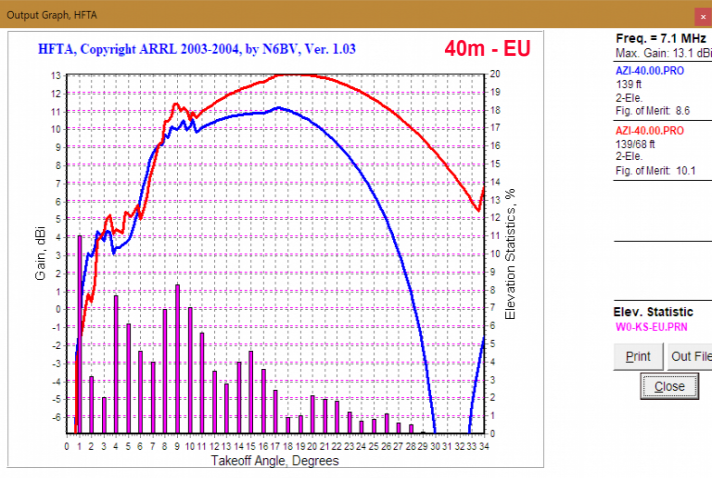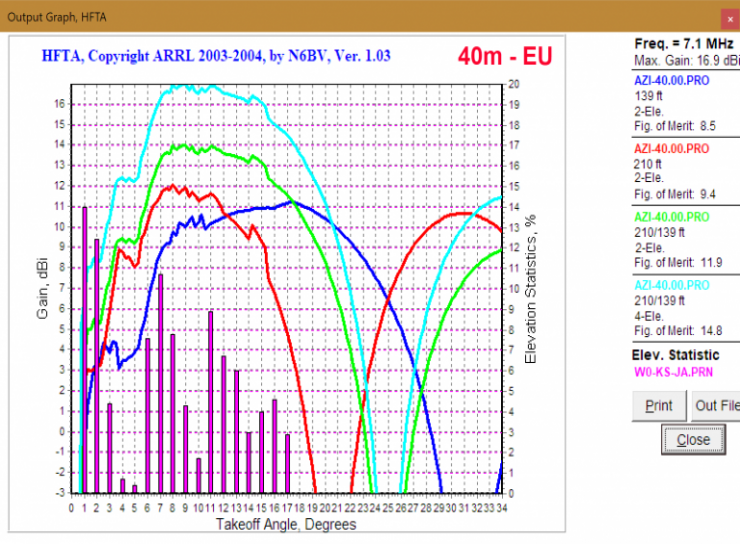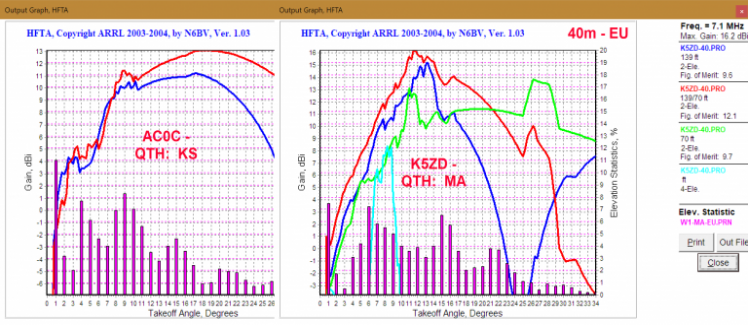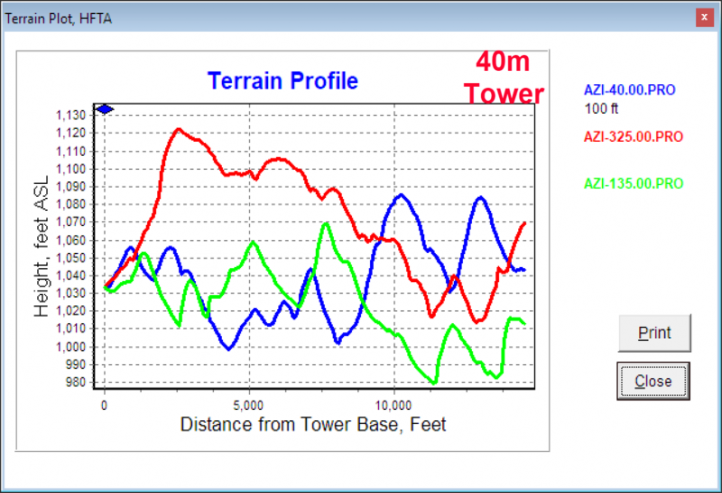2-over-2 40m Stack - JK 402T 2-element Capactive Loaded "Moxon-like" Yagis There is a dividing line the the world of antennas with the 4-element full size 40m beam on one side, and everything else on the other. Full size 40m beams are big, heavy and for that reason need serious towers and even more serious rotors. On the other hand, a full sized 40m beam with some broadband feature (either OWA, dual phased feed, etc) gives excellent F/B, reasonable SWR across both the SSB and CW segments and best in class gain. 40m is a band where there is no "free lunch" - if you want the big beam you are going to have to match that up with a serious tower (no 25G allowed) and a serious rotor. It only takes a couple of minutes searching for comments on big full sized 40m beams to find glowing comments on performance balanced about as often with comments about "it worked great until the last storm" or "it was great but I could not keep a rotor under it." I suppose that's why a properly built full size 40m beam tends to come in at better than 300 lbs. But while you can't get the proverbial free lunch, you can get a very good overall performance package with some of the less massive choices. The most popular of those being the classic Shorty-40 sold by Cushcraft and others. The modern selections from JK provide a good example of what the wide range of beam options (and compromises) are: Model | Type | Ele | Boom Ft | Width Ft | Weight Lbs | Wind Load | Gain dBD | F/R Peak | 2:1 BW | JK402 | Coil loaded | 2 | 18 | 48 | 87 | 8.4 | 4.06 | 20 | 190 KHz | JK402P | Coil + cap hat loaded | 2 | 18 | 36 | 88 | 8.1 | 3.7 | 18 | 250 KHz | JK402T | Cap hat loaded | 2 | 22 | 57 | 125 | 9.3 | 4.1 | 20 | 300 KHz | JK403 | Coil loaded | 3 | 30 | 48 | 125 | 12.6 | 5.06 | 20 | 175 KHz | JK404C | Coil loaded OWA | 4 | 36 | 50 | 160 | 16.8 | 5.26 | 23 | 1.5:1 band | JK404G | Full size OWA | 4 | 44 | 73 | 325 | 28 | 6.16 | >30 | 1.5:1 band |
From the table we can see about a 2.5 dB difference in gain between the smallest and biggest size options. But to get that 2.5 dB requires a 4x increase in weight, about 3x increase in wind load and about a 4x increase in budget not including what is definitely a much bigger rotor requirement. Missing from the chart are 2 and 3 element full size beams which I am guessing these don't offer enough performance benefit to overcome the size/weight issues compared to the variety of loaded options. And from a bandwidth perspective, a quick spin with EZNEC shows just how narrow banded the beam is - definitely a problem if you want wide band operation. There are a lot of considerations in picking the "right" beam for your circumstances. Initial cost of antenna and rotor is key - but I think a lot of hams don't think about survivability especially in locations where the wind blows and the ice falls from the sky. You can go cheap on that 10m beam but going light-weight on a 40m beam is more likely than not to end in tears. My Choice - JK402T
With that set of considerations, I eventually settled on the JK402T - a 2-element capacitively loaded beam similar in configuration to the Moxon. The Moxon type of antenna provides gain, good f/b compared to loaded options, covers both CW and SSB segments with reasonable SWR and has a reasonable size and wind loading meaning I won't have to spin it with a prop pitch rotor. I originally planned to home brew a K3LR Moxon but after getting into the 30m beam decided that was too much of a project and decided to buy one instead. That led me immediately to the JK Antennas offering based on seeing the hardware on display at Dayton in the past. The selection was not difficult.  Why a JK? Why a JK?
I am often asked this so let me list out my personal decision process here. To be clear - I have no business relationship with JK and have received no advantage or other compensation in exchange for my favorable view on the antennas. Just a satisfied customer as they say. I had seen JK's stuff at the last several Dayton shows and it always struck me as impressive. I don't like the large diameter thin wall designs favored by M-squared and had a poor experience with the company related to a KLM KT-34 rebuild that they sold but seemed to have no serious idea about how it worked. A lot of guys like M2 and I'm sure they are fine - but I pulled them off my list for those reasons. Optibeam has a good reputation but they are in Germany and I wanted to deal with a US maker. Additionally they favor a square boom in some cases which I can't wrap my head around, and then there is the metric tubing size which is a problem if you are trying to source replacement aluminum in the US for future repairs. They were similar in price to the other top brands but the import process and associated transportation costs pushed the final price way out of consideration. I think DXE is now distributing Opti and that may help solve some of their problems with the US market. But for all those reasons I pulled Optibeam off my list. Force-12 was in and out of business and had reasonable build quality but a somewhat questionable ability to deliver - when they were said to be in business. I had pulled them off the list as a consideration just from the company stability aspect but it is nice to see the name and the basic designs live on through JK who seems to have picked up the company about the time I was considering who to buy from. Hygain, Cushcraft and similar were not in the build category I was looking for. Some other guys make nice multiband beams but I wanted dedicated monoband designs that were wrung out and single-tasked. That took out Skylark, Mouser, and all of the StepIR stuff as well. Which put me back to JK - who fortunately had a Moxon-type design in the JK402T. That led to adding a big JK206 6-element 20m beam on a 44' boom to put on the top of the 20m tower, and finally to picking up a 15m and 10m for the top slots on those bands. Subsequent exposure to some pretty nasty weather not to mention great contest and DX results led me to the decision to swap out 4 old home brew antennas with JK beams, and to add a 2nd 10m and 2nd 40m JK to whats up bringing the number of JK beams to 10 total. On the other side of the full disclosure, I have had a few issues but they were all in the minor category; got an 80m balun with my 40m beam initially, unclear documentation (in my view), and a couple of other nits. I can't blame 100% of that on JK though - in almost every case I have ordered the antennas with some sort of change or customization. I am fortunate that JK accomidated my request when they could have easily just told me "so sorry OM." And I will say that JK had whatever issue I encountered resolved fast so that I never really had any significant issues. While one can always argue that situations vary, I cannot imagine in retrospect how difficult this project would have been with a less responsive supplier especially given all the weird stuff that I ended up doing. The JK402T BuildThe antenna has been a solid performer and it consistently outperforms my 4-square by s-unit increments, in some cases several s-units. Directivity is solid and it's withstood the 0.4" radial ice loading encountered the first winter. In fact the only difficulty I've had with the beam since it was put up is that I was unable to trim the antenna SWR for reasons unrelated to the antenna. 
Mechanically the construction quality is excellent as illustrated by the cap hat T-assembly shown in the photo here. The beam is a direct-feed 50 ohm type and I mated it with the JK-recommended balun which has excellent common mode rejection numbers based on my own VNA measurements. Assembly of the 40m beam can be done in one day. All the tubing is precut and once you get the hang of how the antenna is put together, it's easy to follow. I used a lot of Pentrox on elements and on screws. And ended up getting my screws put in the wrong orientation a couple of times - but the antenna went together without issue. The JK402T is shown below mounted on the test tower. Unfortunately at only 30' height, the antenna was too close to the ground for it's characteristics to be understood. It worked fine on the 40m tower however. 
Stack Plans and RevisionsThe original plan was to put the JK at the top so I would have a mechanically-stable antenna at the top of the rotor. And then add a homebrew Moxon conversion of the Cushcraft Shorty lower on the tower and fixed on EU to provide a stack. Modeling showed some nice benefits to a pair of the generic Moxon in a stack especially in improved pattern. A local had made me a nice offer on a Cushcraft he was planning to replace so the path was clear. And then I did the work to assemble all the 4 JKs that are up now, rebuild the KLM 15, clean up the other home-brew OWA as well as build the 17/30m dual bander. In short, the reworked shorty plan was made before I literally had my fill of antenna work. And the 2nd year the plan is to replace 4 of the old home brew beams with new JK models, the plan to use the Cushcraft was looking like a less and less fun project. Eventually I decided to just buy another JK402T as it was the simplest solution. Before placing the order, I had considered putting a JK404C at the top, and moving the JK402T to the fixed-on-EU position. It was a roughly 2x project - more than 2x the cost, about 2x the wind load, and it would require more crane time to move the existing beam down the tower (not to mention more nerve-racking time hanging off the mast steps). The existing rotor (AlphaSPID Big RAK) is probably capable of the added load even with the big 30m beam up there now. But after a few weeks of thinking about it I decided that was a lot of time, money and work to get what comes down to about 1 dB of added gain. The final decision was to mount a 2nd JK402T at the fixed-on-EU position. What the Model Says
The blue line is the elevation plot with the top antenna only. The red line represents the top and bottom antenna working as a stack with the two antennas fed in-phase. The stack configuration does a few things for us all at the same time. 1. More gain = louder signals 2. The forward lobe is taller and the response notch (which was at 30 deg) has moved up to the less critical 40 deg meaning you are heard as louder over a wider range of elevations. 3. The big 50 deg second lobe on the top-only case is greatly reduced and in my case that means effectively turning the volume down on the east coast signals which come in at the higher angle. The stack favors DX by about 3 S-units! And on the back side response the similar high angle lobe there drops about 6 db doing the same thing against west coast stations. 4. The notch at the vertical 90 deg signals is greatly attenuated so QRN from directly overhead is less than with the single antenna case. A stack is a marvelous thing! HFTA AnalysisOpinions vary as to the best way of working out antenna mounting heights for a tower. My preference is to optimize the stack spacing using AutoEZ, then take those spacings and see how it looks in HFTA - adjusting the final mounting heights based on what HFTA says. EZNEC assumes that the ground is flat and uniform. In reality that's of course not the case. HFTA takes into account the topology of ground and makes some basic assumptions of antenna pattern/gain when doing the ground bounce calculations and plots an estimate of relative antenna strength over a range of DX locations. For that reason determining the final height of a stack is a task best left to HFTA. In the 40m case, I took the optimum heights from the AutoEZ/EZNEC model and looked at a mounting band in HFTA that was about +/- 10 feet. Here's what the final height choices looked like in HFTA using a ground model drawn from the actual tower location and assuming the stack is beaming EU. BLUE is the TOP beam alone; RED is the stack. 
HFTA and What-If?An interesting exercise to perform is a what-if scenario just to put reality in perspective with a less limited case. In my situation, I am constrained to a tower height of about 130'. That means a peak mounted height of about 145' as an absolute maximum. But what if you don't have a height limit? And what if you are able to put up bigger antennas? What would that do for the signal? HFTA makes it easy to look at what a more ideal case would be, not one constrained by the reality of height limits and budget. In the plot below we have a number of cases. BLUE - the single antenna at 139'. This is reality for me. RED - the antenna pushed up 210'. That's about a wavelength higher. The gain, especially at lower angles benefits. GREEN - now let's add a 2nd antenna and make it into a stack - in this case heights of 210' + 139'. More gain again, and a wider range of angles. CYAN - Keep the same height as green, but change out our 2 element beams for a pair of 4 element beams. That gives us about another 3db. So with the combination of adding another 70' and switching from 2 to 4 element beams, we can gain about one S-unit (~5 dB) improvement. 
Another what-if would be to see how our signal compares with the same antenna setup of someone in a favored location for contesting - that means east coast. K5ZD has published his terrain files and so we can match up the same EU-beaming path at his MA located QTH and see how it looks to my KS QTH. Below are a trio of calculations, all assuming the 40-degree EU-facing direction and with the analysis based on Randy's actual terrain. The color codes on the right side graph represent these cases: RED - the same STACK antenna/tower combination as I have here. 2 over 2 at 139/70 feet BLUE - top only, same as I have here. 2 elements at 139 feet GREEN - bottom only, same as I have here. 2 elements at 70 feet So we can compare the stack cases direction by looking at the two red lines IF WE ASSUME THE LOCAL TERRAIN IS ROUGHLY THE SAME (a pretty big IF). There are a few things we can may be able to intuit from the two: 1. Notice where the clusters of signals appear - the first peak is at about 4 deg elevation, and the 2nd cluster is at 9 deg. The same peaks for the east coast MA QTH are at 6 and 15 deg. This puts a premium on low angles which is why "higher is better" often proves to be the case on 40m. But the stack advantage works on the east coast just as in KS - note where the K5ZD null shows up at about 25 deg in the single 139' high beam case (BLUE); while not in the high density of the EU pack, it's still in a place where we would prefer it not. The options are to lower the beam a bit which would shift the notch to the right at some expense in the lowest angle strengths, or to add a 2nd beam lower and move to a stack. 2. Looking at strengths for the same angle sets (4 deg KS vs. 6 deg MA and 9 deg KS vs. 15 deg MA) shows a location advantage of 5 dB and 3 dB respectively meaning for the same antenna/tower configuration, we expect the east coast station to have a 3-5 dB strength advantage. That also implies that if we want to have the same signal strength from a KS location as a MA location, it would require something along the line of the earlier big-tower and big-beam case that to make up the difference - that is a 210'+139' height 4 over 4 stack! It also means that a single beam at 70' on the east coast sounds about the same as a 139'+70' stack of the same beams in KS. As in the real estate business, it's QTH QTH QTH! 
TerrainThe terrain at this location is average to poor, depending on what you compare it too. Another local K3PA lives on Charlie Brown's pitching mound - that is his tower sets on a local hill where the land slopes off pretty significantly in every direction except north. It's worth a relative 3-6 dB compared to my site simply because the local QTH terrain favors him over me - especially when I look (uphill) to JA/Asia... The primary contest bearings are shown in the terrain profile below. Off to SA is more or less flat. Off to EU is more favorable with a nice drop off at 1/2 mile and then there is the local mountain climb (a mountain in KS is anything bigger than 100') that we have heading for JA. 
40m Beam vs. 40m 4-square?While the 40m beam is almost always better than the 4-square, it has one deficiency - it cannot quickly change directions like a 4-square can. In fact the 4-square is a very nice complement to the beam in that I can leave the beam pointed on EU and then use the 4-square to catch SA, JA or the OC guys with the flick of the switch. In these other directions the 4-square is generally adequate to the task. So when asked "what's better?" I generally reply that I would keep the beam if an either-or requirement was made. But having the pair provides an excellent contest advantage for just about anything the beam is not pointing too - especially if you have to fight a bit to get the guy in the log. |